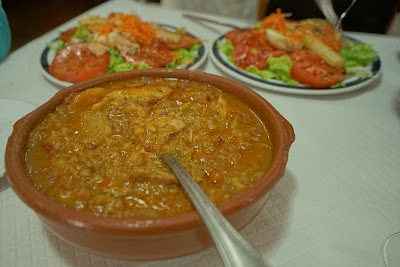Even though Hotel Antsotegi outside Markina is a well-bulit lodge, the service is sparse and the breakfast set-up rough around the edges as two brothers, sons of the owner, busily run around to take care of the guests. But their hospitality is undeniable. One of them offers to take us to the town center when we ask him to call a taxi. It is only a mile away but again we are trying to save energy whenever we have to deviate from the Camino. We gladly take him up on his offer. He wants to drive us beyond Markina to Iruzubieta which is where he says the scenery improves, he says. I explain that I need to walk every kilometer on the Camino and we get off in the center of Markina to join Sunjin. We also see the Korean school group again who had to check out of the municipal albergue even though they plan to stay another day there (it's just the albergue rules). The good news is the two backpacks that were stolen in Itiziar a few days ago have been returned (albeit without valuable content) - the local police had worked hard on tracking the owners down after what is surely an embarrassing event to them. The boy with a foot injury, however, has not seen a doctor, and I tell them about a podologia klinika near the city hall.
 |
| Prayer flags? Are we in Tibet? No, the owner of this hotel just outside Markina is an avid mountain climber and lover of Nepal (and has helped recent earthquake victims). |
 |
| Leaving Markina: the first part of the route to Iruzubieta is nice enough. |
 |
| If you are going to be in someone's doghouse, let it be a Basque one. |
 |
| Iruzubieta: petunia in full bloom. We find a bar right on the Camino, which is always convenient. |
 |
| Bored or hungary, or both... |
 |
| These solidly built and well-decorated Basque houses never cease to impress me. |
 |
| Bolivar: the scallop shell design at the entrance of this brightly colored town shows respect for the pilgrims. |
 |
| Kiwi fruit galore |
 |
| Bolivar: noticing a museum sign (left) above a message for pilgrims |
 |
| Bolivar: Museum honoring Simon Bolivar (right) |
 |
| Simon Bolivar, a South American hero who embraced Enlightenment and equality of man |
 |
| Bolivar: locals chat on the main drag. |
 |
| Bolivar: looking back at the town after a steep climb |
The second delightful visit is at Monasterio de Zenarruza near the top of the hill in Ziortza. It is simple but serene. The Peruvian woman we saw yesterday was going to walk all the way to an albergue nearby. It takes at least a couple of hours to walk from Markina so she would have arrived here in the evening and probably has moved on. Given that both Bolivar Museum and this monastery are open only for a few hours in the morning, she is likely to have missed the interiors of both. We do not see a single other pilgrim today and I expected it since most of them probably left Markina or points further ahead and most of them are faster than us.
 |
| Ziortza: Monasterio de Zenarruza |
 |
| Ziortza: Monasterio de Zenarruza. St. James is depicted in the left lower corner of the reredos. |
 |
| Ziortza: Monasterio de Zenarruza. The tranquil cloister in a remote mountain monastery |
 |
| The dry portion coming up is always welcome. But is that redwood trees ahead? I had been lulled into thinking that I am hiking in California anyway. |
 |
| Grass covering the trail - good, rocks - bad. |
 |
| Pears galore |
 |
| Noticing a bunch of walnuts we picked up from the ground, a passing local advises us to let the walnut dry for some time before eating. |
 |
| Finally arriving in Munitibar |
 |
| Munitibar: A collection of hats from Mus Tournaments at Txori Taberna where we wait for a taxi to take us back to Markina. (Mus is a card game of probable Basque origin.) |
 |
| Back in Markina: ordering a peregrino menu again, aided by a booklet of ingredients in eight languages that the serving lady proudly displays. Almost as accurate as google-translate! |
 |
| Markina: ordering Marmitako again. For the main course, I try Saltxitxa (a type of sausage). The three-course meal, costing 10 euros, can probably feed three people. |
No comments:
Post a Comment